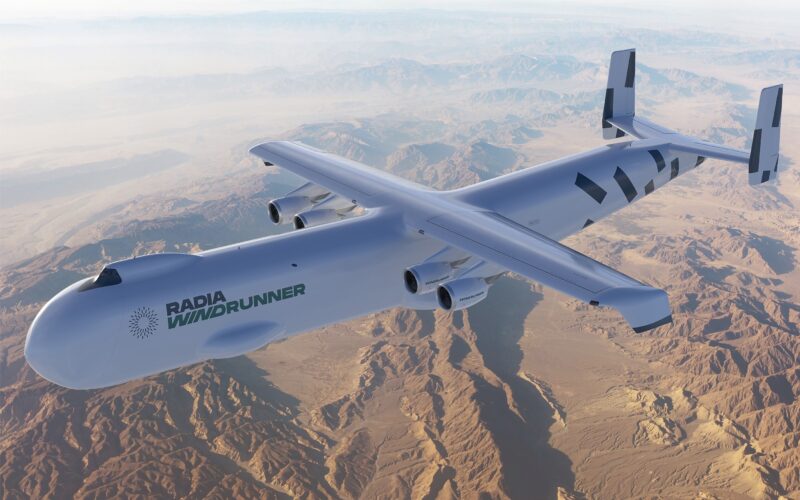Aviation
Meet WindRunner: The World’s Heaviest and Largest Aircraft Ever Built

In the ever-evolving landscape of renewable energy, where innovation meets ambition, a US-based energy start-up named Radia is poised to redefine the future of both aviation and the wind industry.
At the heart of their groundbreaking vision lies the WindRunner, an extraordinary aircraft designed to set new records and revolutionize how we approach clean energy transportation.
WindRunner is not just an aircraft; it is a colossal flying machine that, when fully certified, will hold the title of the largest and heaviest aircraft ever built by humankind.
Unveiling the Future: A Glimpse into the Next Generation of Airbus Wings:Click here
With dimensions that dwarf even the most iconic airplanes in history, WindRunner is a feat of engineering designed to transport the world’s largest onshore wind turbines to remote, hard-to-reach locations—places where conventional transportation methods fall short.
This mammoth aircraft, which spans 356 feet in length, is 127 feet longer than a Boeing 747-400 and boasts a wingspan of 261 feet. Its towering height of 79 feet is a testament to its unparalleled design, tailored specifically to meet the demands of the modern wind industry.
WindRunner’s cargo bay volume is equally impressive, measuring 272,000 cubic feet—enough to accommodate the equivalent of three Olympic swimming pools. To put this into perspective, that’s 12 times the volume of a Boeing 747-400.
10 fastest fighter jets in the world:Click here
But WindRunner’s capabilities extend far beyond its sheer size. It is engineered to transport massive cargoes, including wind turbine blades up to 300 feet in length, directly to wind farms. With a maximum payload capacity of 160,000 pounds, this aircraft can carry cargoes up to 344 feet long, 24 feet high, and 24 feet wide—dimensions that push the boundaries of what was previously thought possible in airborne transportation.
To date, Radia has secured nearly $100 million in funding from a consortium of external investors. This substantial financial backing underscores the confidence in WindRunner’s potential to transform the renewable energy landscape.

Aviation
Airbus Enhances A350 Cabin with 10-Abreast Seating

Airbus has announced a new partnership with Jiatai Aircraft Equipment, a Chinese aircraft seating manufacturer, to supply upgraded economy-class seats for the A350 widebody series.
This collaboration, unveiled at the 2024 Airshow China, focuses on developing a newly designed economy seat tailored for the A350‘s New Production Standard (NPS) cabin.
One of the key features of the NPS cabin is the ability to accommodate 17-inch wide economy seats, compared to the previous 16.5-inch wide seats that airlines were limited to in the A350’s earlier configurations.
British Airways Unveils Its Brand-New First Class Cabin for the Airbus A380
This change is made possible by the expanded space in the NPS cabin, which is 35 inches longer and 4 inches wider than the previous version. This extra space is achieved by slightly moving the cockpit wall forward and shifting the rear pressure bulkhead back by one frame.
The wider cabin allows airlines to add up to 30 extra economy seats without compromising comfort. For airlines opting for a 3-4-3 seating layout, the 17-inch wide seats are an excellent choice for a more comfortable passenger experience. However, some airlines, such as Iberia, may choose to retain a 9-abreast layout with wider seats for added comfort.
The NPS cabin also offers enhanced flexibility for airline operators. One major advantage is the ability to easily switch between a 9-abreast and 10-abreast seating configuration without requiring significant downtime for aircraft reconfiguration. Airlines can use the same seat rails, tracks, and IFE interfaces, making the transition smoother and quicker.
Etihad Airways Unveils 10 Exciting New Routes for 2025
In addition, the design of the floor attachments and air-conditioning systems has been optimized for 10-abreast seating, meaning airlines can upgrade their cabins without needing to make substantial modifications to the aircraft’s structure.
Though it’s still unclear when Jiatai’s economy-class seats will be officially added to the A350’s Buyer Furnished Equipment (BFE) catalogue, the collaboration marks a significant step toward enhancing the A350’s cabin offerings.
With this partnership, Airbus is providing more seating options for airlines, ensuring that they can meet diverse customer needs while improving overall operational efficiency.
-

 Aviation2 months ago
Aviation2 months agoMicrosoft Flight Simulator Raises $3 Million to Bring Back the An-225 Mriya
-

 Airlines2 months ago
Airlines2 months agoQatar Citizens Can Travel to the United States Without a Visa
-

 Aviation2 months ago
Aviation2 months agoQatar Airways bans these new Electronic Devices on plane
-

 Airlines2 months ago
Airlines2 months agoJapan Airlines Rolls Out Free Domestic Flights to International Passengers
-

 Defence2 months ago
Defence2 months agoWhich Country Has the Largest Fleet of Fighter Aircraft?
-

 Airport2 months ago
Airport2 months agoWestern Sydney Airport Welcomes Its First Plane After 6 Years of construction
-

 Airlines4 days ago
Airlines4 days agoDAMAC Air: Dubai’s New Luxury Airline Offers Free Flights for Registration
-

 Aviation2 months ago
Aviation2 months agoDid you know ? Once Boeing 747 carried 1088 passenger in 1991








